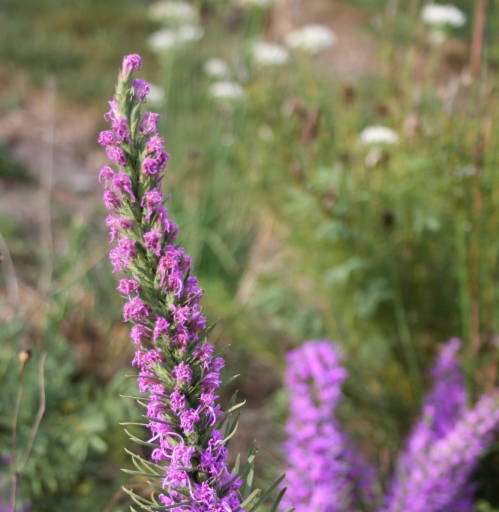Prairie plants deserve more use in home landscapes. They can transform an “Anywhere, USA” yard into a place that preserves the unique beauty of Nebraska’s plains heritage. And natives play a vital role for pollinators as both habitat and food source. Many of these plants are lovely in their own right, so we’ll give some attention to a few lesser-known beauties. Some may be hard to find at a garden center, but they should be available from local or mail-order nurseries specializing in native plants.
Western sandcherry, Prunus besseyi. The airy, fountain-like habit and gentle, swaying plumage of this shrub bring a peaceful mood to the garden. White flowers in April or May; leaves turn mahogany red in fall; August fruits can be enjoyed in pies, preserves and wine. Works best en masse. Grows 4-6 feet high and wide; smaller ‘Pawnee Buttes’ grows to 3 feet high. Prefers full sun and sandy soil with good drainage.
White wild indigo, Baptisia lactea (B. alba), is perhaps the most architectural of prairie plants, with bundles of smooth, regal stalks that rise up and fan out into elegant stems with velvety foliage. Snow-white flowers on ink-blue spikes in June; black seedpods add winter intrigue. Nice in a border or as a specimen plant. Grows 3-4 feet high and 2 feet wide. B. australis blooms azure blue and B. minor stays under 3 feet. Prefers good drainage and full or part sun; tolerates clay and drought.
Fox sedge, Carex vulpinoidea, has glossy, vivid green foliage that emerges early in spring and persists into late fall. Soft, wispy blades and a fountain form offer refined structure and texture. Deep roots filter water pollutants and improve the soil. Great among flowers and in rain gardens. Grows 1-3 feet high and 1-2 feet wide in full sun to part shade and tolerates heavy clay. It prefers consistently moist soil but C. brevior is an alternative for drier conditions.
American hazelnut, Corylus americana. This handsome, adaptable shrub produces edible nuts (two plants required for nut production) encased in a peculiar, ruffled wrapper and relished by birds and other wildlife. Leaves turn orange, yellow and red in fall. Makes an excellent specimen or screen along borders and background plantings. Grows 6-8 feet high and wide. Prefers part shade and protection from wind and tolerates sun, drought and clay.
Blue grama, Bouteloua gracilis, has grey-green foliage that is soft and fine, curling happily beneath eyelash seedheads that shine in the summer sun and remain as winter interest. A shortgrass that serves well as a specimen, en masse or even as a low-input lawn with buffalograss. Grows about 1 feet high. Extremely drought tolerant; needs full sun and dry, well-drained soil.
Dotted gayfeather, Liatris punctata. Prime time is late summer when this short and stout gayfeather dresses in show-stopper amethyst flower spikes to attract a buzz of butterflies and bees. Pair with complementary blooms like false sunflower for a superb landscape display. Grows 1-2 feet high and 1 feet wide in sun and well-drained soil. Extremely drought-tolerant.
Indiangrass, Sorghastrum nutans. This statuesque grass brings movement and texture into the garden with its attractive, rustling foliage. In late summer, radiant flower plumes rise from towering, golden wands to waltz with the Nebraska wind. Blue-green blades turn yellow in fall. A fantastic back-of-the-border plant or informal screen. Grows 5 feet high and 3 feet wide. Full sun and dry soil keeps it upright.
Shining bluestar, Amsonia illustris, is a superstar of the plant world, exhibiting soft blue flowers in spring and a perfectly mounded form with clean, willowy foliage that burns a fiery yellow in autumn. They serve as fine companions to bold foliage and flowers and polish off any border. Grows 3 feet high and wide in sun or shade. Tolerates drought but prefers fairly moist soil.

